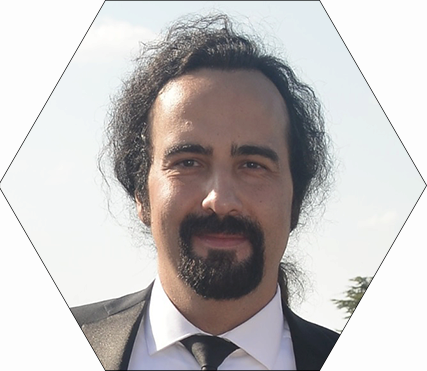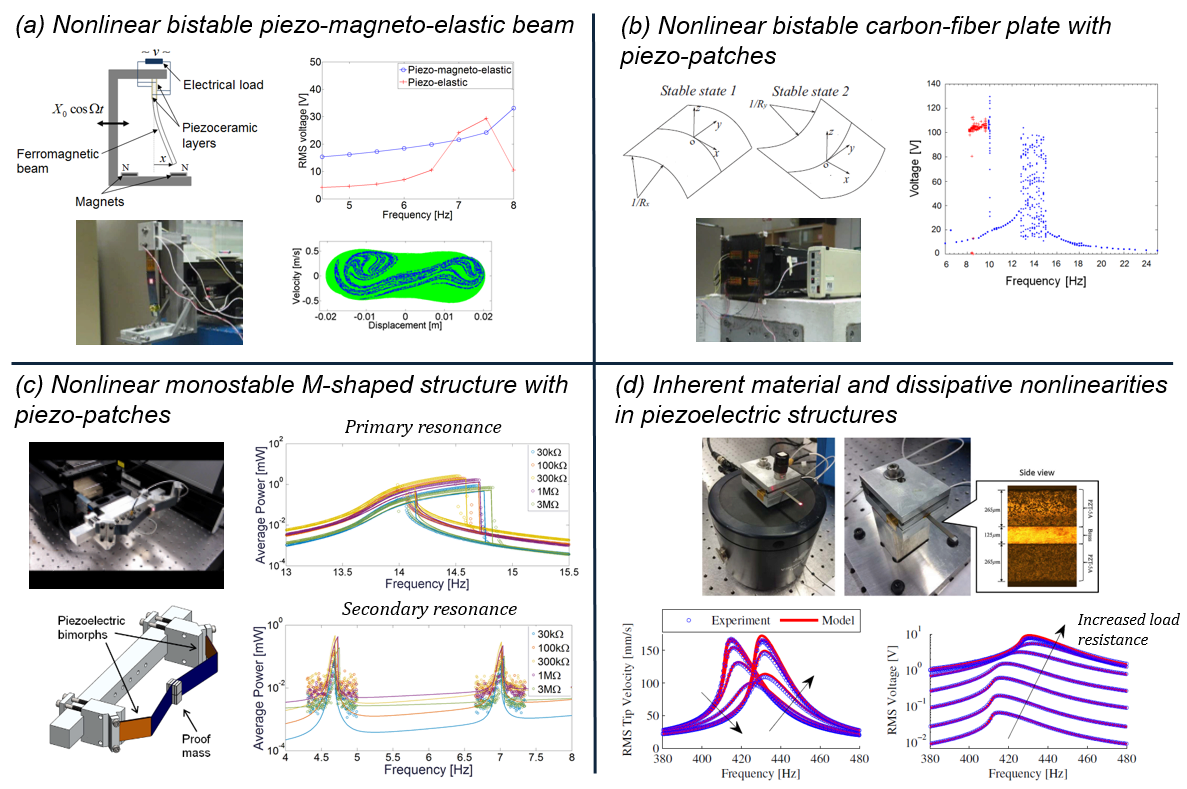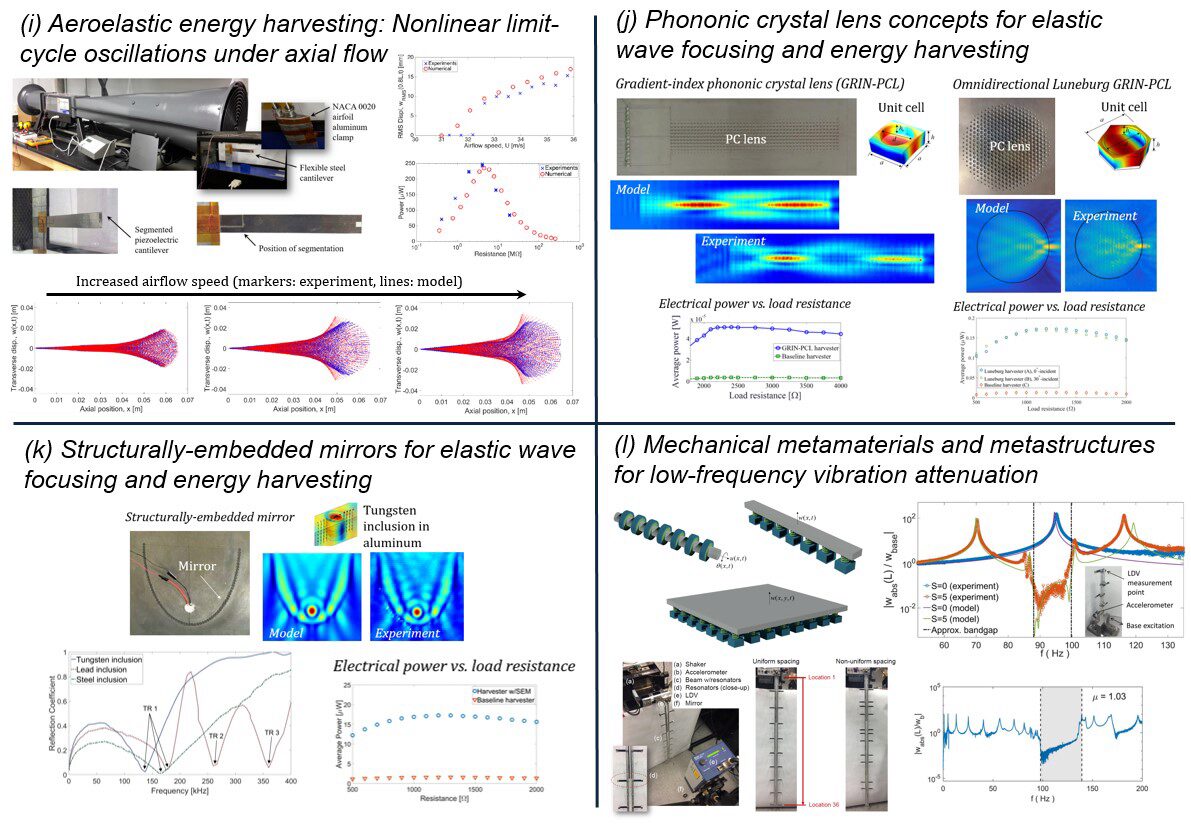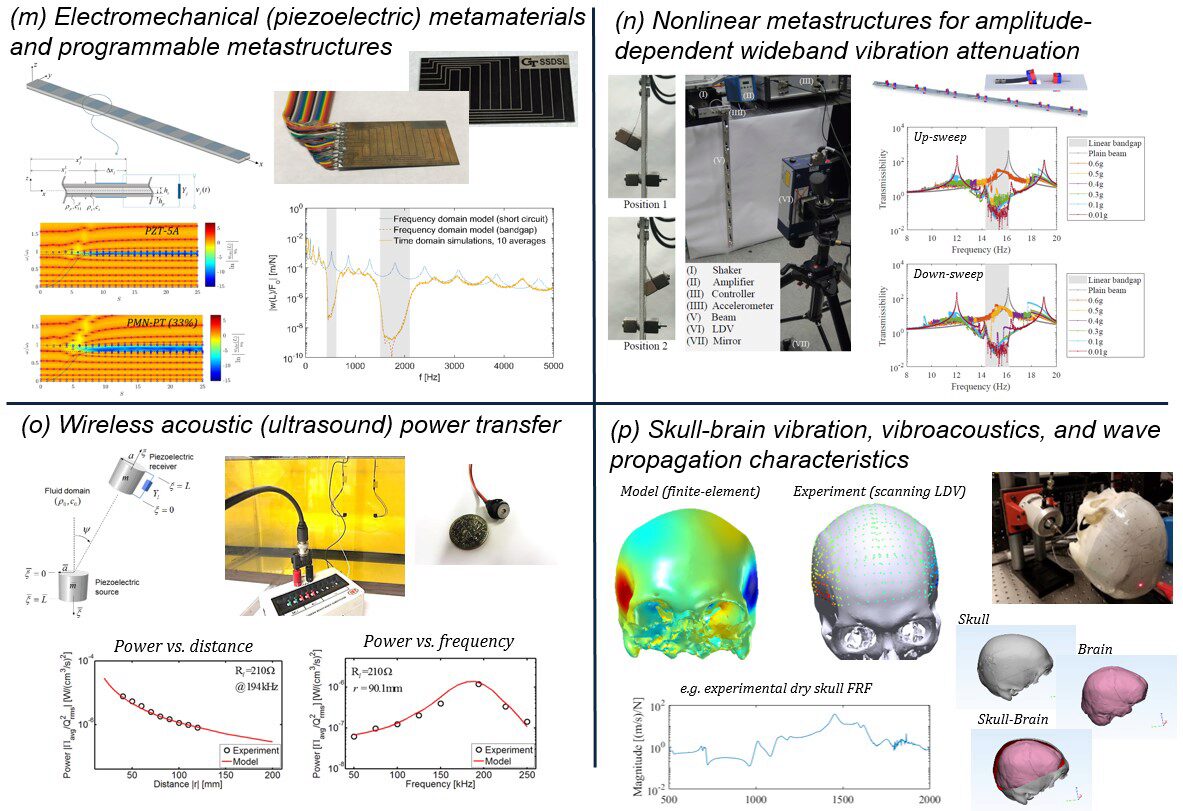Education
- Ph.D., Engineering Mechanics, Virginia Tech, 2009
- M.S., Mechanical Engineering, METU, 2006
- B.S., Mechanical Engineering, METU, 2004
Background
Dr. Erturk began at Georgia Tech in 2011 as an Assistant Professor, he was promoted to Associate Professor with tenure in 2016 (and Woodruff Faculty Fellow in 2017-2019), became a full Professor (and was named Woodruff Professor) in 2019, and was named Carl Ring Family Chair in 2022. Prior to joining Georgia Tech, he worked as a Research Scientist at Virginia Tech (2009-2011), where he received his Ph.D. in Engineering Mechanics in 2009. Dr. Erturk's research aims to understand, control, and leverage vibration and wave phenomena across geometric scales, disciplines, and applications. His sponsored research topics have covered a broad spectrum including energy harvesting from vibrating and other dynamical systems, leveraging nonlinear dynamics in smart structures, bio-inspired piezoelectric actuation/locomotion, mechanical and electromechanical metamaterials for elastic wave control and vibration attenuation, elastic/acoustic wave guiding using phononic crystals, wireless (ultrasonic) power and data transfer, understanding and exploiting vibration and wave phenomena in biomechanical systems (e.g. human skull-brain system), among other topics.
Research
- Acoustics and Dynamics and Mechanics of Materials: Structural dynamics; linear and nonlinear vibration of electromechanical systems; theoretical and experimental modal analysis; smart materials and structures; energy harvesting from dynamical systems; bio-inspired piezoelectric sensing and actuation; wave propagation; elastic/acoustic metamaterials and metastructures; phononic crystals; wireless acoustic power transfer; vibration/vibroacoustics and wave propagation in biomechanical systems; machine tool vibration.
- Carl Ring Family Chair, 2022-present
- Philip E. Doak Award, Journal of Sound and Vibration (Elsevier), 2021
- Invited Professor, KAIST (Korea Advanced Institute of Science and Technology), Department of Aerospace Engineering, 2021-present
- SEM James W. Dally Young Investigator Award, 2020
- Fellow of SPIE (International Society for Optics and Photonics), 2020
- Institute Lecture, IIT Kanpur, 2019
- Woodruff Professor of Mechanical Engineering, 2019-2024
- Invited (Adjunct) Professor, Politecnico di Milano, Dipartimento di Meccanica, 2018-present
- ASME IDETC 2018 Mechanical Vibration & Noise Conference Chair
- SPIE Smart Structures/NDE 2018 Active & Passive Smart Structures & Integrated Systems Conference Chair
- Hesburgh Award Teaching Fellow (2018)
- Senior Member of SPIE (elected in 2018)
- Fellow of ASME (elected in 2017)
- Woodruff Faculty Fellow, 2017-2022
- ASME C.D. Mote Jr., Early Career Award, 2017
- ASME Energy Harvesting Best Paper Award, 2017
- CIOS Teaching Effectiveness Award, 2016
- ASME Journal of Vibration and Acoustics, Associate Editor, 2017-
- TASSA Young Scholar Award (faculty level), 2016
- ASME Gary Anderson Early Achievement Award, 2015
- ASME Energy Harvesting Best Paper Award (inaugural), 2015
- ASCE Journal of Energy Engineering, Associate Editor, 2015-
- Thank a Teacher Certificates, 2013-2014
- NSF CAREER Award, 2013
- Sigma Xi Georgia Tech Chapter, Best MS Thesis Award (for S. Zhao), Advisor, 2013
- CETL Class of 1969 Teaching Fellow, 2012-2013
- Best Student Paper Award (for S. Zhao), ASME Conference on Smart Materials, Adaptive Structures and Intelligent Systems, Advisor, 2012
- Smart Materials and Structures, Associate Editor, 2013-present
- Journal of Intelligent Material Systems and Structures, Guest Editor, 2011-2012, Associate Editor, 2012-present
- ASME Conference on Smart Materials, Adaptive Structures and Intelligent Systems (SMASIS), Symposium Chair, 2012
- ASME International Design Engineering Technical Conferences (IDETC), Symposium Co-chair, 2012-present
- ASME Energy Harvesting Technical Committee, Founding Chair, 2012-2014, Member, 2014-
- ASME Design Engineering Division, Technical Committee on Vibration and Sound, Elected Member, 2011-2014, 2014-2017
- ASME Aerospace Division, Adaptive Structures and Material Systems Branch, Elected Member, 2011-present
- Most cited articles in Smart Materials and Structures, Journal of Intelligent Material Systems and Structures, Journal of Vibration and Acoustics, 2009-2010
- Featured and most downloaded article in Applied Physics Letters, July 2009
- ASME SMASIS Best Student Paper Awards, coauthor, 2009 and 2010
- Virginia Polytechnic Institute and State University, Liviu Librescu Memorial Scholarship, 2008
- The Parlar Foundation, Middle East Technical University, Thesis of the Year Award, 2006
Representative Publications
- Sugino, C., Ruzzene, M., and Erturk, A., 2018, “Design and Analysis of Piezoelectric Metamaterial Beams with Synthetic Impedance Shunt Circuits,” IEEE/ASME Transactions on Mechatronics, 23, pp. 2144-2155.
- Sousa, V.C., Tan, D., De Marqui, Jr., C., and Erturk, A., 2018, “Tunable Metamaterial Beam with Shape Memory Alloy Resonators: Theory and Experiment,” Applied Physics Letters, 113, 143502.
- Silva, T., Clementino, M., De Marqui, Jr., C., and Erturk, A., 2018, “An Experimentally Validated Piezoelectric Nonlinear Energy Sink for Wideband Vibration Attenuation,” Journal of Sound and Vibration, 437, pp. 68-78.
- Tan, D., Yavarow, P., and Erturk, A., 2018, “Resonant Nonlinearities of Macro-Fiber Composite Cantilevers with Interdigitated Electrodes in Energy Harvesting,” Nonlinear Dynamics, 92, pp. 1935-1945.
- De Marqui, Jr., C., Tan, D., and Erturk, A., 2018, “On the Electrode Segmentation for Piezoelectric Energy Harvesting from Nonlinear Limit Cycle Oscillations in Axial Flow,” Journal of Fluids and Structures, 82, pp. 492-504.
- Sousa, V.C., Sugino, C., De Marqui, Jr., C., and Erturk, A., 2018, “Adaptive Locally Resonant Metamaterials Leveraging Shape Memory Alloys,” Journal of Applied Physics, 124, 064505.
- Tan, D., Yavarow, P., and Erturk, A., 2018, “Nonlinear Elastodynamics of Piezoelectric Macro-Fiber Composites with Interdigitated Electrodes for Resonant Actuation,” Composite Structures, 187, pp. 137-143.
- Sugino, C., Ruzzene, M., and Erturk, A., 2018, “Merging Mechanical and Electromechanical Bandgaps in Locally Resonant Metamaterials and Metastructures,” Journal of the Mechanics and Physics of Solids, 116, pp. 323-333.
- Silva, T., Clementino, M., Erturk, A., and De Marqui, Jr., C. 2018, “Equivalent Electrical Circuit Framework for Nonlinear and High Quality Factor Piezoelectric Structures,” Mechatronics, 54, pp. 133-143.
- Tol, S., Degertekin, F.L., and Erturk, A., 2017, “Structurally-Embedded Reflectors and Mirrors for Elastic Wave Focusing and Energy Harvesting,” Journal of Applied Physics, 122, 164503.
- Sugino, C., Xia, Y., Leadenham, S., Ruzzene, M., and Erturk, A., 2017, “A General Theory for Bandgap Estimation in Locally Resonant Metastructures,” Journal of Sound and Vibration, 406, pp. 104-123.
- Tol, S., Degertekin, F.L., and Erturk, A., 2017, “Phononic Crystal Luneburg Lens for Omnidirectional Elastic Wave Focusing and Energy Harvesting,” Applied Physics Letters, 111, 013503.
- Tol, S., Xia, Y., Ruzzene, M., and Erturk, A., 2017, “Self-Bending Elastic Waves and Obstacle Circumventing in Wireless Power Transfer,” Applied Physics Letters, 110, 163505.
- Sugino, C., Leadenham, S., Ruzzene, M., and Erturk, A., 2017, “An Investigation of Electroelastic Bandgap Formation in Locally Resonant Piezoelectric Metastructures,” Smart Materials and Structures, 26, 055029.
- Moura, A.G. and Erturk, A., 2017, “Electroelastodynamics of Flexoelectric Energy Conversion and Harvesting in Elastic Dielectrics,” Journal of Applied Physics, 121, 064110.
- Shahab, S. and Erturk, A., 2017, “Coupling of Experimentally Validated Electroelastic Dynamics and Mixing Rules Formulation for Macro-Fiber Composite Piezoelectric Structures,” Journal of Intelligent Material Systems and Structures, 28, pp. 1575–1588.
- Sugino, C., Leadenham, S., Ruzzene, M., and Erturk, A., 2016, “On the Mechanism of Bandgap Formation in Locally Resonant Finite Elastic Metamaterials,” Journal of Applied Physics, 120, 134501.
- Tol, S., Degertekin, F.L., and Erturk, A., 2016, “Gradient-Index Phononic Crystal Lens-based Enhancement of Elastic Wave Energy Harvesting,” Applied Physics Letters, 109, 063902.
- Shahab, S. and Erturk, A., 2016, “Electrohydroelastic Euler-Bernoulli-Morison Model for Underwater Resonant Actuation of Macro-Fiber Composite Cantilevers,” Smart Materials and Structures, 25, 105007.
- Erturk, A., 2015, “Macro-Fiber Composite Actuated Piezoelectric Robotic Fish,” Chapter 9 in Robot Fish: Bio-Inspired Fishlike Underwater Robots, pp. 255-283, Springer, New York (Eds. Du, R., Li, Z., Youcef-Toumi, K., and Valdivia y Alvarado, P).
- Leadenham, S. and Erturk, A., 2015, “Nonlinear M-Shaped Broadband Piezoelectric Energy Harvester for Very Low Base Accelerations: Primary and Secondary Resonances,” Smart Materials and Structures, 24, 055021.
- Shahab, S., Gray, M., and Erturk, A., 2015, “Ultrasonic Power Transfer from a Spherical Acoustic Wave Source to a Free-Free Piezoelectric Receiver: Modeling and Experiment,” Journal of Applied Physics, 117, 104903.
- Leadenham, S. and Erturk, A., 2015, “Unified Nonlinear Electroelastic Dynamics of a Bimorph Piezoelectric Cantilever for Energy Harvesting, Sensing, and Actuation,” Nonlinear Dynamics, 79, pp. 1727-1743.
- Leadenham, S. and Erturk, A., 2014, “M-Shaped Asymmetric Nonlinear Oscillator for Broadband Vibration Energy Harvesting: Harmonic Balance Analysis and Experimental Validation,” Journal of Sound and Vibration, 333, pp. 6209-6223.
- Anton, S.R., Farinholt, K.M., and Erturk, A., 2014, “Piezoelectret Foam-based Vibration Energy Harvesting,” Journal of Intelligent Material Systems and Structures, 25, pp. 1681-1692.
- Deng, Q., Kammoun, M., Erturk, A., and Sharma, P., 2014, “Nanoscale Flexoelectric Energy Harvesting,” International Journal of Solids and Structures, 51, pp. 3218-3225.
- Daqaq, M.F., Masana, R., Erturk, A., and Quinn, D.D., 2014, “On the Role of Nonlinearities in Vibratory Energy Harvesting: A Critical Review and Discussion,” ASME Applied Mechanics Reviews, 66, 040801.
- Carrara, M., Cacan, M.R., Toussaint, J., Leamy, M.J., Ruzzene, M., and Erturk, A., 2013, “Metamaterial-Inspired Structures and Concepts for Elastoacoustic Wave Energy Harvesting,” Smart Materials and Structures, 22, 065004.
- Zhao, S. and Erturk, A., 2013, “On the Stochastic Excitation of Monostable and Bistable Electroelastic Power Generators: Relative Advantages and Tradeoffs in a Physical System,” Applied Physics Letters, 102, 103902.
- Cunefare, K.A., Skow, E.A., Erturk, A., Savor, J., Verma, N., and Cacan, M.R., 2013, “Energy Harvesting from Hydraulic Pressure Fluctuations,” Smart Materials and Structures, 22, 025036.
- Cen, L. and Erturk, A., 2013, “Bio-Inspired Aquatic Robotics by Untethered Piezohydroelastic Actuation,” Bioinspiration and Biomimetics, 8, 016006.
- Zhao, S. and Erturk, A., 2013, “Electroelastic Modeling and Experimental Validations of Piezoelectric Energy Harvesting from Broadband Random Vibrations of Cantilevered Bimorphs,” Smart Materials and Structures, 22, 015002.
- Anton, S.R., Erturk, A., and Inman, D.J., 2012, “Multifunctional Unmanned Aerial Vehicle Wing Spar for Low-Power Generation and Storage,” AIAA Journal of Aircraft, 49, pp. 292-301.
- Erturk, A. and Delporte, G., 2011, “Underwater Thrust and Power Generation Using Flexible Piezoelectric Composites: An Experimental Investigation Toward Self-Powered Swimmer-Sensor Platforms,” Smart Materials and Structures, 20, 125013.
- Erturk, A. and Inman, D.J., 2011, “Broadband Piezoelectric Power Generation on High-Energy Orbits of the Bistable Duffing Oscillator with Electromechanical Coupling,” Journal of Sound and Vibration, 330, pp. 2339-2353.
- Stanton, S.C., Erturk, A., Mann, B.P., and Inman, D.J., 2010, “Resonant Manifestation of Intrinsic Nonlinearity within Electroelastic Micropower Generators,” Applied Physics Letters, 97, 254101.
- Anton, S.R., Erturk, A., and Inman, D.J., 2010, “Multifunctional Self-Charging Structures using Piezoceramics and Thin-Film Batteries,” Smart Materials and Structures, 19, 115021.
- Stanton, S.C., Erturk, A., Mann, B.P., and Inman, D.J., 2010, “Nonlinear Piezoelectricity in Electroelastic Energy Harvesters: Modeling and Experimental Identification,” Journal of Applied Physics, 108, 074903.
- Kong, N., Ha, D.S., Erturk, A., and Inman, D.J., 2010, “Resistive Impedance Matching Circuit for Piezoelectric Energy Harvesting,” Journal of Intelligent Material Systems and Structures, 21, pp. 1293-1302.
- Arrieta, A.F., Hagedorn, P., Erturk, A., and Inman, D.J., 2010, “A Piezoelectric Bistable Plate for Nonlinear Broadband Energy Harvesting,” Applied Physics Letters, 97, 104102.
- Erturk, A., Vieira, W.G.R., De Marqui, Jr., C., and Inman, D.J., 2010, “On the Energy Harvesting Potential of Piezoaeroelastic Systems,” Applied Physics Letters, 96, 184103.
- Erturk, A., Hoffmann, J., and Inman, D.J., 2009, “A Piezomagnetoelastic Structure for Broadband Vibration Energy Harvesting,” Applied Physics Letters, 94, 254102.
- Erturk, A.and Inman, D.J., 2009, “An Experimentally Validated Bimorph Cantilever Model for Piezoelectric Energy Harvesting from Base Excitations,” Smart Materials and Structures, 18, 025009.
- Erturk, A. and Inman, D.J., 2008, “A Distributed Parameter Electromechanical Model for Cantilevered Piezoelectric Energy Harvesters,” ASME Journal of Vibration and Acoustics, 130, 041002.
- Erturk, A., Budak, E., and Ozguven H.N., 2007, “Selection of Design and Operational Parameters in Spindle-Holder-Tool Assemblies for Maximum Chatter Stability by Using a New Analytical Model,” International Journal of Machine Tools and Manufacture, 47, pp. 1401-1409.
- Budak, E., Erturk, A., and Ozguven, H.N., 2006, “A Modeling Approach for Analysis and Improvement of Spindle-Holder-Tool Assembly Dynamics,” CIRP Annals – Manufacturing Technology, 55, pp. 369-372.
- Erturk, A., Ozguven, H.N., and Budak, E., 2006, “Analytical Modeling of Spindle-Tool Dynamics on Machine Tools using Timoshenko Beam Model and Receptance Coupling for the Prediction of Tool Point FRF,” International Journal of Machine Tools and Manufacture, 46, pp. 1901-1912.




